|
Stein Collectors International, Inc. |
|
by SCI Master Steinologist Ron Fox (Originally published in Prosit, June 1988) |
 |
Drinking vessels have been made from many different materials throughout the centuries. In this article we will examine those made of glass. Chemically, glass is a silicate. It is made from sand melted in a furnace with the aid of an alkaline flux. Glass is considered a liquid in solid form. The properties of glass change according to the change of its components. Soda ash was used in all old glass made from the 15th through the 17th centuries, and was obtained from the ash of seaweed from the Mediterranean. This gave the glass a soft nature which hardened slowly. Potash, obtained from the ash of deciduous trees, had been used as early as the 11th century. It gave the glass a very hard nature which hardened quickly. Soda ash gave the glass blowers more time to work the glass, as it was more malleable. In the 18th century lead oxide was substituted as the flux. Lead oxide melted easily, was soft, and gave the glass a brilliant shine. With the complex cutting used in the late 19th century this was the most suitable flux.
The natural color of glass is actually a light green or light brown (because of impurities in the several ingredients). In order to give glass a clear look it had to be de-colored. This was done by adding manganese dioxide. Manganese dioxide is reddish-violet in color which, being the complementary color when used in correct proportions, cancels out the light green. Other chemicals were also used which achieved the same result.
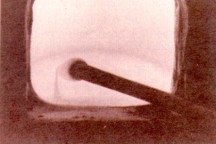 |
| Build-up of glass on end of blow pipe in furnace: "gathering". |
 |
| Gathering of glass on blow pipe before any blowing has taken place. |
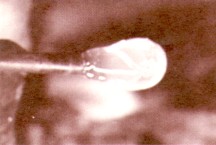 |
| Gathering of glass as it is first being blown into via pipe. |
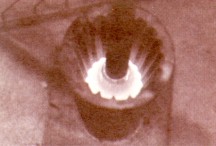 |
| Gathering of glass being blown into steel mold. |
 |
| Mold-blown glass being re-heated to keep it in pliable form. |
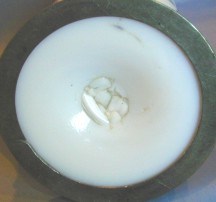 |
| Pontil mark on glass base. |
There are three ways to shape glass: freehand blowing, mold blowing and pressed.
A. Freehand Blown:
With this shaping method the desired glass mix was put into a clay pot within a furnace. When heated to 1100 degrees Fahrenheit (about 600º C), the ingredients melted or liquified. The glass worker would work with a long, hollow iron rod which he would lay into the clay pot through a hole or small door in the furnace. A ball of glass would form and be "gathered" on the end of this rod. The rod with the glass ball was then removed from the pot and the opposite end of this rod or blow pipe would then be blown into by mouth. The taffy-like ball of glass would begin to inflate. The glass worker would have to keep reheating the glass to keep it in this pliable state. It was also necessary for the glass blower to keep spinning the blow pipe to create a centrifugal force which neutralized the gravitational pull which would have pulled the glass "balloon" out of shape. He would shape the glass by using water-soaked wood paddles of various shapes and sizes, thus producing the desired effect. More blowing enlarged the piece to the desired size. At this point, a solid rod or pontil was attached to the opposite end of the glass. The hollow rod, or blow pipe, was then cut free. This enabled the worker to continue to hold the hot glass and widen and shape the opening from which it was blown. A gathering of glass was then attached to the side of the body and then pulled up or down to make the handle. It was then put into an annealing kiln that slowly allowed the temperature to drop. The cooling process had to be done slowly or the glass would crack or shatter.
B. Mold-Blown Glass
Wood molds: With this glass blowing method, glass was gathered at the end of the blow pipe. It was then blown into a wooden mold which would give it the predesignated shape. While the glass was being blown there would be a continuous spinning of the rod to eliminate mold marks in the two-part water-soaked wood mold. The shaping paddles and wood molds would remain in water when not in use.
Metal molds: If reliefs or indentations were desired on the body, the glass was blown into metal molds. This enabled the glass worker to achieve the desired designs without cutting or grinding. The only difference was that, in this process, the glass was blown into a carefully designed metal mold instead of being freehand blown. It is easy to distinguish a metal-blown piece, as the interior will be indented in those areas where the exterior is extended. The interior pattern will be the exact opposite of the outside design. Regardless of whether wood or metal molds were used, the handle was attached in the same manner as in the freehand blown process. The use of the pontil rod to permit shaping and widening the opening was also the same. Because the mold-blown glass used carefully shaped molds, the resultant shape is always perfect. A piece of glass that is freehand blown will be uneven and not perfectly round. Close examination could reveal which process was used.
C. Pressed Glass
The easiest and most common method of making drinking vessels is the pressed glass method. Here metal two-part or three-part molds were used. The liquid glass was poured into the mold and a plunger would force the glass into the mold body and handle cavity, thus shaping the body into a single piece of glass. When cooled, the plunger would be removed, the molds would be stripped away, and the glass maker would be left with a single complete body, handle and all. But the mold seams are always visible, always in the center of the handle and on the front of the piece in a two-part mold, or to either side in a three-part mold. The inside of a piece of pressed glass is always cylindrical while the outside takes on the shape of the mold.
It is easy to tell the difference between blown and pressed glass steins: Simply look where the handle meets the body. On blown steins the handle and body are two separate pieces of glass joined together, but still noticeably separate. On pressed glass steins, the handle and body are one piece of glass. This distinction, plus the presence of mold seams, make pressed glass easily recognizable.
 |
 |
| Left, pressed glass handle showing mold marks at the centerline of the handle, continuing on the body. Right, typical handle attachment on a pressed glass stein, handle and body are a single piece of glass. | |
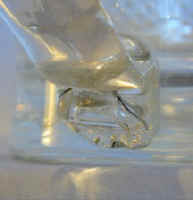 |
 |
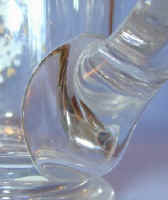 |
| Three examples of attached handles on blown glass steins. Earlier examples (left) are much less regular than those achieved toward the latter part of the 19th century (middle and right). | ||
Coloring the Glass
There are numerous ways to add color to glass. The most common method is to mix different oxides into the glass to give it various solid colors. This is done to produce glass such as milk glass, cranberry, cobalt, amber, etc.
A. Flashing:
Another glass coloring method is called flashing. This is accomplished after a metallic oxide is applied to the body and the glass is reheated. The oxide provides the color and leaves a thin translucent layer on the surface of the glass. By scratching, cutting or engraving this layer the clear glass underneath is revealed. This can create many different effects commonly called "cut-to-clear". The colors created are quite bold and give the same appearance as solid colored glass.
B. Overlay:
Another coloring method is the overlay process. This is achieved when the glass blower had a ball of glass on the end of his pipe and inserts that ball into the furnace into a pot of differently colored glass. This second color will then encase the first layer. This can be done several times to achieve numerous layers. This overlay process can be done with freehand blown or mold-blown pieces, but is usually done with mold-blown.
C. Lustre:
A lustre is achieved by tinting the exterior of the glass with a metallic oxide vapor. A small amount of the oxide is inserted into the kiln in a special container. The heat in the kiln transforms the oxide into a gas which is trapped in the kiln and coats the clear glass surface with a very thin layer of iridescent color.
Glass Decorating
 |
| Enameling on glass. |
Very often we encounter glass steins with hand-painting on them. This is done with the use of glass enamels. Enamels are made up of frit and metallic oxides. The frit gives the enamel body while the oxides provide the color. Frit is previously-made glass ground into a powder. The frit is mixed with metallic oxides (colors) and oil to make it paintable. These three ingredients form the enamel paint which is applied onto the body of the piece. When the glass is refired, the oil burns off, leaving the oxide and frit fused into a thin layer of glass which is then a permanent part of the body. This enameling can be applied via direct hand-painting or via a transfer. On occasion a combination of the two can be used by first transferring the design and then accenting it with hand-painting.
On certain steins made in the mid 1800's it was common to hand-paint glass drinking vessels both on the outside and on the inside of the piece. Because of space limitations the inside painting was restricted to simple designs. It achieved the effect of another color dimension which was highly desirable.
B. Cold Painting:
During the 16th and 17th centuries one method of glass decorating was cold painting. This method employed direct hand-painting with air-drying lacquer paints. Because these painted decorations were not fired on, they usually wore off in a short period of time. Fired-on enamels replaced this method because of their lasting durability.
C. Diamond-Point Engraving:
The use of diamond-point engraving dates back to the 16th century. With this decorating method an artist worked with a diamond or hard metal tool which he used to scratch the glass surface with linear designs. All designs were surface decorations, as the artist could not scratch too deeply into the glass body. Upon close examination of an engraved surface you will detect only linear designs, as the engraver was limited to the restrictions of the engraving tool. This decorating method became obsolete with the advent of copper wheel engraving.
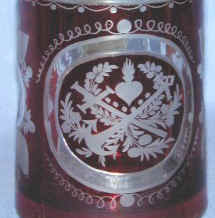 |
| Copper wheel cut through ruby flashing (ruby cut to clear). |
D. Copper Wheel Engraving (Intaglio):
This method of glass decorating employed the use of a kick-wheel spindle apparatus which turned the copper disc at high speed. This copper disk was usually the size of a penny and was used as a cutting device to engrave designs onto blown glass. The artist had a free hand in this type of decoration and could cut a design to whatever depth he desired, from very shallow to a deep cut. A pumice-like material was used to cut down the friction and do the actual cutting. Copper wheel engraving was used mainly to do full scenes rather than linear designs. It is possible to use both copper wheel and stone wheel cutting on the same body, depending on the decoration desired.
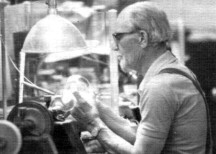 |
 |
| Glass cutter at work. | Glass being wheel cut. |
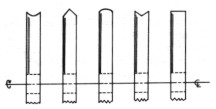 |
|
| Examples of stone wheel profiles. | |
 |
| Stone wheel ground or cut ("cut glass"). |
 |
| Pressed glass with acid-etched ram's head. |
With this decorating process, the same type of apparatus as used with copper wheel engraving was utilized. But instead of copper discs being used as cutting tools, different stone wheels of varied circumferences, thicknesses and profiles were used. The profile, or edge shape, of the cutting stone would dictate the design shape cut into the glass body. By changing the stone cutting wheel, the artist had the flexibility to creating varying shapes and thickness of cuts on a single glass body. The number of different profiles available allowed the artist a great deal of creativity in producing designs. Stone wheel cutting was never used for pictorial scenes. Its purpose was to create patterns and designs which were multi-faceted. These designs were meant to create a sparkling effect. That is why glass so decorated is also called "cut glass". After the grooves and cuts of the design were completed they were polished to an even sheen so they matched the rest of the body. This was done with the use of polishing compound (pumice) and spinning pads.
F. Acid Etching:
This decorating method was achieved by using hydrofluoric acid. The areas of the glass body not to be decorated were protected by applying wax, varnish, tar, or a grease. The unprotected areas were either dipped into or brushed with this acid which etched the glass and gave the surface a pitted, frosted look. This decorating process was usually used on all types of clear glass. An acid-etched design would be easily recognized by its frosted appearance.
G. Applied Glass Decoration:
Another decorating method used quite often was applied glass decorations. This refers to prunts, belly bands, wriggle designs, etc. These could be in the same or contrasting colors. They were applied to the exterior of the glass body by attaching a gathering of glass. This decoration method was only used on blown glass pieces. The applied decorations were attached when the glass was at a high temperature while being molded or shaped.
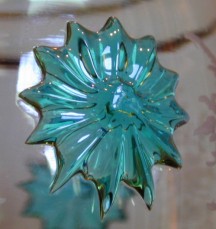 |
 |
| Applied glass prunt, blue on amber base. | Applied glass rippled base ("rigaree"). |
Damages and Repairs
Because glass is a translucent material certain damages are permanent and cannot be repaired. Once glass is broken or cracked, it can never be mended without the repair being noticeable. Chips, however, can be removed depending on where they are located. If the chip is on the base, rim, or even on parts of the handle, it is possible to grind down the surrounding surface so the chip no longer exists. If, however, the chip is severe, too much grinding would make this repair either impossible or impractical.
|
All rights reserved. |